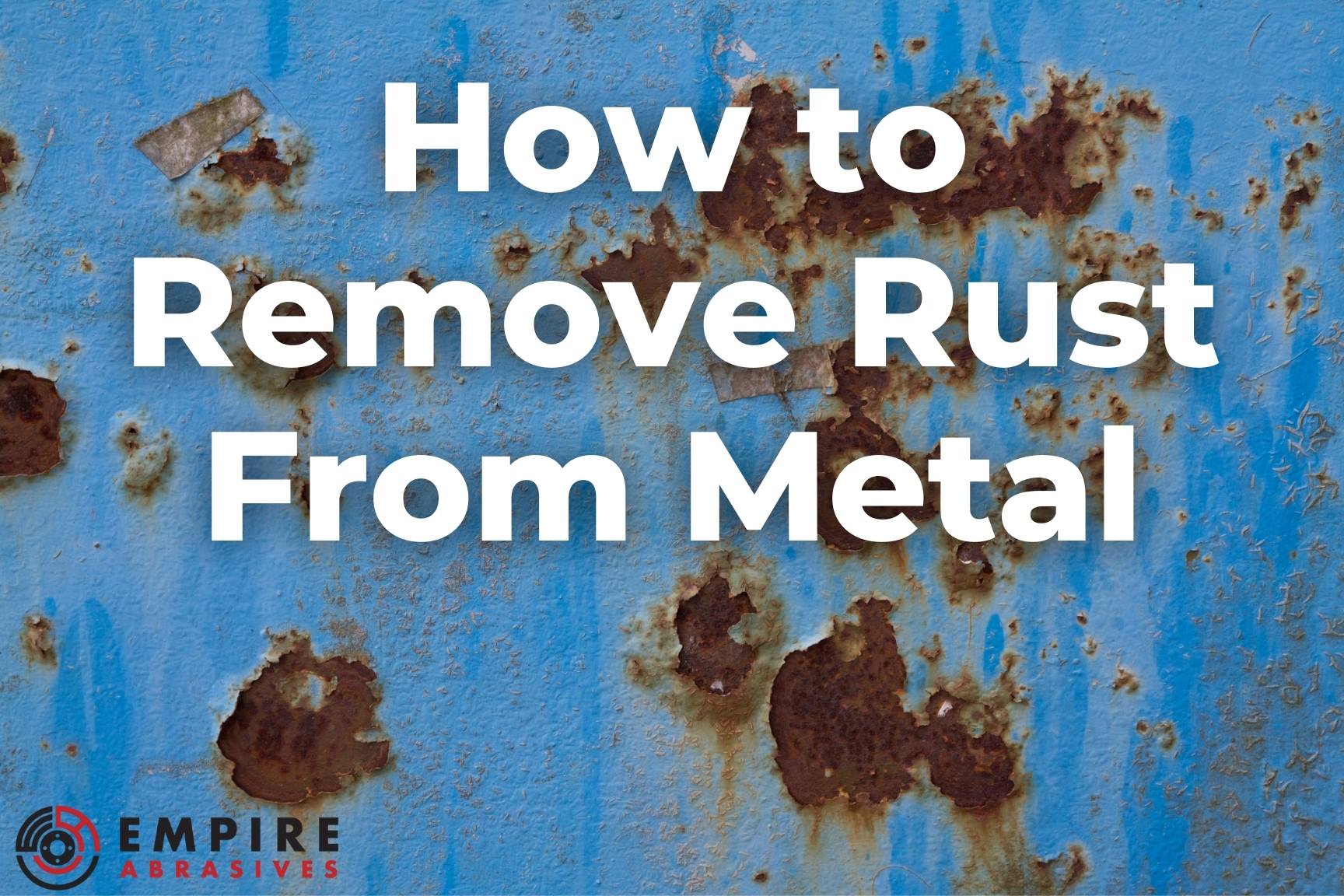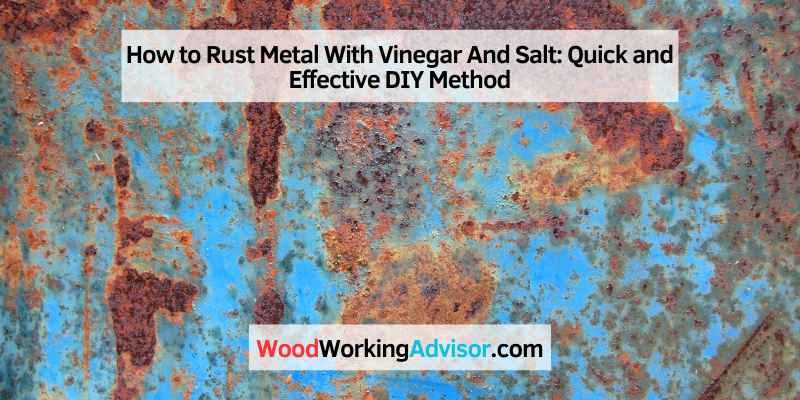To rust metal with vinegar and salt, create a mixture and soak the metal overnight. This process accelerates rusting.
Rusting metal with vinegar and salt is a simple DIY method that can add character to your metal items. With just a few household ingredients, you can achieve a rustic and aged look on metal surfaces. This technique is commonly used in crafting and DIY projects to create a weathered appearance on metal objects.
By using vinegar as an acidic solution and salt as a catalyst, you can speed up the oxidation process and produce a rusted patina on the metal. This natural and cost-effective method is environmentally friendly and allows you to customize the level of rusting based on your preference.
How To Rust Metal With Vinegar And Salt
Rusting metal with vinegar and salt is an easy and cost-effective way to achieve a weathered and rustic look for your projects. This method creates a natural rust patina that adds character and uniqueness to your metal items.
Choosing The Right Materials
- Select a metal item made of iron or steel.
- Ensure the metal is clean and free of any coatings.
- Gather white vinegar, table salt, and a spray bottle.
Preparing The Metal Surface
- Clean the metal item thoroughly with soap and water.
- Dry the metal completely to prevent water spots.
- Create a mixture of vinegar and salt in the spray bottle.
- Spray the solution evenly over the metal surface.
- Let the metal sit overnight to allow the rusting process to occur.

Credit: www.finewoodworking.com
Creating The Rusting Solution
Learn how to rust metal with vinegar and salt using a simple DIY solution. This method provides a natural and cost-effective way to achieve that vintage, weathered look on metal surfaces for a rustic aesthetic. With just a few ingredients and some easy steps, you can create the rusting solution at home.
Measuring Vinegar And Salt
To create the rusting solution, measure the vinegar and salt precisely.
Mixing The Solution
Combine the vinegar and salt in a container to form the rusting solution.
Applying The Rusting Solution
Applying the rusting solution is a critical step in rusting metal using vinegar and salt. This is where the magic happens, as the solution starts to work its oxidizing wonders on the metal surface. Understanding the proper technique for applying the rusting solution is essential for achieving the desired rusty finish on your metal items.
Dipping Or Spraying The Solution
When applying the rusting solution, you have the option to either dip the metal object directly into the vinegar and salt mixture or spray the solution onto the metal surface using a spray bottle. Both methods can yield excellent results, so choose the one that suits your specific item and available resources.
Allowing The Reaction To Occur
Once the rusting solution has been applied to the metal, it is crucial to allow sufficient time for the chemical reaction to occur. Patience is key during this stage, as the rusting process may take several hours to a few days depending on the size and composition of the metal. Be sure to monitor the progress periodically to determine when the desired level of rusting has been achieved.
Enhancing The Rusting Process
Rusting metal with vinegar and salt is a popular DIY technique that can give your projects a rustic, weathered look. But what if you want to take it a step further and enhance the rusting process? In this section, we’ll explore two optional methods that can add more texture and accelerate the rusting.
Adding Additional Texture (optional)
While rusting metal with vinegar and salt creates a naturally textured surface, you can further enhance the texture by introducing additional elements. One way to do this is by spraying or dabbing small amounts of hydrogen peroxide onto the metal surface. The peroxide will react with the rust and add interesting variations in color and texture.
Accelerating The Rusting (optional)
If you’re looking to speed up the rusting process, there are a few methods you can try. One option is to create a more concentrated vinegar and salt solution by increasing the amount of salt. This higher salt concentration will intensify the rusting reaction and help the metal oxidize faster.
Another method is to expose the metal to moisture for longer periods. You can achieve this by wrapping the metal in a damp cloth or placing it outside in a humid environment. The moisture will promote oxidation and result in quicker rusting.
Additionally, you can introduce heat to accelerate the rusting process. Placing the metal object near a heat source, such as a heater or a hairdryer on a low setting, can increase the rate of oxidation. However, it’s important to exercise caution and monitor the process closely to avoid any potential safety hazards.
Remember, these additional techniques are optional and can be used to experiment and achieve the desired level of texture and rusting. Feel free to try different combinations and methods to personalize your rusting project.
Finishing And Sealing The Rust
To finish and seal rust on metal, using vinegar and salt is an effective method. This DIY process involves creating a rust mixture with the two ingredients, applying it to the metal surface, and allowing it to sit before sealing it with a protective coating.
Rinsing And Drying The Metal
Once the desired level of rust has been achieved by using vinegar and salt on your metal surface, it’s important to prepare it for sealing. One crucial step in this process is rinsing off the excess vinegar and salt solution to prevent further corrosion. Begin by thoroughly rinsing the metal with clean water, ensuring that all residue is removed. This step will help to neutralize the acidity of the vinegar and prevent any potential damage to the metal surface.
After rinsing, it’s essential to dry the metal completely before proceeding with the sealing process. This can be done by wiping the surface with a clean cloth or using compressed air to ensure that no moisture remains. Drying the metal is crucial to prevent any future rust formation and to ensure the effectiveness of the sealant application.
Applying A Protective Sealant
Now that the metal has been rinsed and dried, it’s time to apply a protective sealant to prevent future rusting. There are various options available for sealants, but one popular choice is clear acrylic spray. This sealant not only provides a protective barrier against moisture, but it also enhances the appearance of the rusted metal with a glossy finish.
To apply the sealant, hold the spray can at a distance of approximately 8-12 inches from the surface of the metal. Begin spraying in even, sweeping motions, making sure to cover the entire rusted area. Apply multiple thin coats rather than one heavy coat to achieve the best results. Allow each coat to dry completely before applying the next.
In addition to clear acrylic spray, other sealants such as polyurethane or wax can also be used to protect and seal the rusted metal. Simply follow the manufacturer’s instructions for proper application and drying times. Remember that the sealant acts as a barrier, preventing moisture and oxygen from reaching the metal and causing additional rust.
By rinsing and drying the metal properly and applying a protective sealant, you can not only stop the rusting process but also enjoy a beautifully preserved rusted finish. Whether you are upcycling an old piece of metal furniture or adding unique accents to your home decor, mastering the art of rusting and sealing can help you achieve stunning and durable results.

Credit: www.empireabrasives.com
Frequently Asked Questions On How To Rust Metal With Vinegar And Salt
Can Vinegar And Salt Rust Metal?
Yes, vinegar and salt can rust metal because they create a chemical reaction that corrodes the metal’s surface. The acidity of vinegar and the electrolytic properties of salt speed up the rusting process, causing the metal to corrode and form rust.
How Long Does It Take For Vinegar And Salt To Rust Metal?
The time it takes for vinegar and salt to rust metal varies depending on factors like the type of metal and the concentration of the vinegar. In general, it may take a few hours to a few days for noticeable rusting to occur.
Do I Need To Remove Rust Before Using Vinegar And Salt?
It is not necessary to remove rust before using vinegar and salt. The rusting process can be accelerated by applying the vinegar and salt directly onto the rusted areas. The combination of vinegar and salt will work to dissolve the rust and remove it from the metal surface.
What Precautions Should I Take When Rusting Metal With Vinegar And Salt?
When rusting metal with vinegar and salt, it is essential to wear gloves and protective eyewear to prevent direct contact with the solution. Additionally, ensure proper ventilation as vinegar fumes can be strong. It is also advisable to work in a well-ventilated area and clean up any spills immediately.
Conclusion
To sum up, rusting metal with vinegar and salt is a simple, cost-effective, and eco-friendly method for achieving a weathered, antique look. By following the steps outlined in this guide, you can easily create unique and aged metal pieces for various DIY projects.
Embrace this natural rusting process and let your creativity flourish with this environmentally conscious technique.


